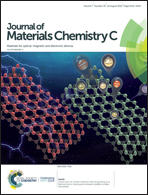Gas sensors based on assembled porous graphene multilayer frameworks for DMMP detection†
Abstract
Graphene is a promising material for gas sensing, but high-performance gas sensors often require a robust structural design in order to endow the resultant sensing devices with batch uniformity, good response, sensitivity, and selectivity. In this study, a novel gas sensor based on assembled porous reduced graphene oxide (rGO) multilayer frameworks was designed and fabricated for gas sensing. To this end, negatively charged holey graphene oxide (GO) and positively charged holey graphene oxide (rGO) were assembled on gold (Au) electrodes through electrostatic interactions to form a porous structural framework. A reduction process was then performed to ensure the formation of a porous framework composed of the r(GO/rGO)n multilayers. The combined chemical assembly, etching and modification methods resulted in porous r(GO/rGO)n multilayers with an increased specific surface area. This improved the gas sensor response towards dimethyl methylphosphonate (DMMP) vapour at room temperature. The sensor that was assembled with 12 layers of porous graphene (r(GO/rGO)12) showed a resistance change reaching 8.95% in the presence of 50 ppm DMMP vapour. This value was 3-fold higher than that obtained with the sensor constructed with one-layered graphene. At the low DMMP vapour concentration of 1 ppm, the resistance change in (r(GO/rGO)12) reached a substantial 2.21%. Furthermore, the assembled porous r(GO/rGO)12 sensor showed good repeatability, excellent stability, good uniformity, and elevated selectivity towards DMMP vapour. Overall, the proposed concept looks promising for the design of future high-performance gas sensing devices with broad applications.



 Please wait while we load your content...
Please wait while we load your content...